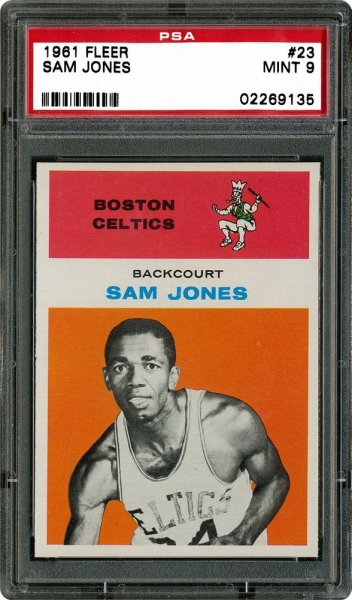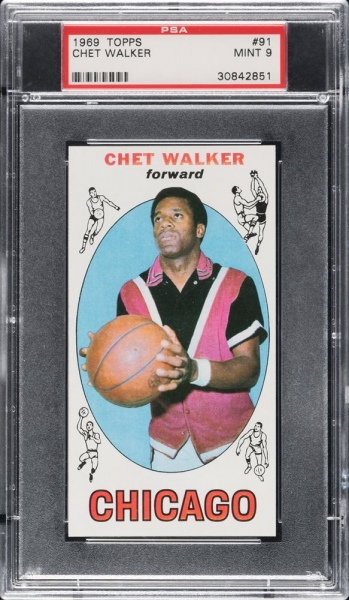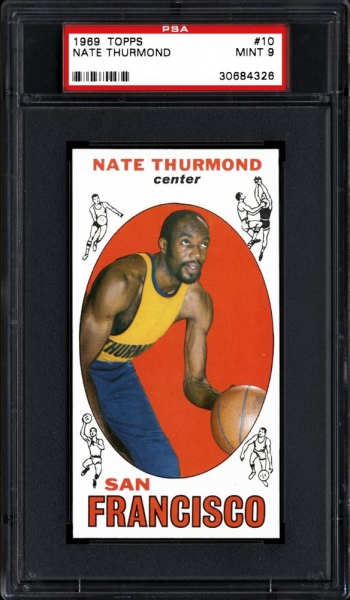Overlooked and Underrated Rookie Cards of NBA Greats – Part 2, the 1960s

As was the case in the earliest days of professional basketball, in the 1960s the limelight focused squarely on a select few greats: Russell and Wilt, Jerry West, Oscar Robertson and the still-undercelebrated Elgin Baylor. Left in their wake was another collection of Hall of Famers, including the likes of Jerry Lucas, Zelmo Beaty, Walt Bellamy, Bailey Howell, Lenny Wilkens, Earl Monroe and Nate Archibald.
These, of course, were still the days of hiatuses in mainstream basketball card production. As a result, an incredible crop of rookie cards of some all-time greats slipped through the cracks (relatively speaking), despite these players’ achievements and impact on the game. Despite the fact that just two mainstream sets were released in the decade, compiling a comprehensive list of woefully underrated ’60s rookie cards is a massive undertaking. Presenting a different, if equally great challenge, is selecting only four…
Hal Greer (1961 Fleer, #16)
Total PSA pop: 561 (one PSA 10, 25 9s, 8 8.5, 155 8s, 5 7.5, 137 7s, 4 6.5, 92 6s, 14 5.5, 59 5s)
One of the most consistent and durable superstars of the 1960s, Greer spent fifteen seasons in the NBA, all with a single franchise – the Syracuse Nationals, who drafted him in 1958, and became the Philadelphia 76ers in 1963. Over that decade and a half, Greer took part in 1,122 regular season games, averaging 19.2 point, five rebounds and four assists.
When he retired in 1973, Greer did so as the league’s all-time leader in games played, and third-leading scorer, with 21,588 points. He remains, by some margin, the Sixers’ all-time leader in both categories, and still ranks second in franchise history in assists, fourth in Win Shares (less than four behind Barkley and Dr. J in third and second), and sixth in rebounds.
During his ten-year prime (1960-70), Greer averaged 22 points and nearly six rebounds, and earned ten consecutive All-Star selections, and seven straight Second Team All-NBA nods.
In 1967, Greer teamed up with Wilt, Billy Cunningham and Chet Walker to lead the Sixers to their first Philadelphia title. He was Philly’s top scorer that postseason, averaging up 27.7 points (plus 5.9 rebounds and 5,3 assists) to help the Sixers past Oscar’s Cincinnati Royals, the Russell’s Celtics and Rick Barry’s Warriors.
No matter how you slice up Greer’s body of work, he is a superstar and a legend. That he’s not readily regarded as such is owed largely to the fact that he was only the undisputed best player on his team for about three years. His early years coincided with Dolph Schayes’ late prime, and his peak was spent with Wilt. Beyond that, we can look to a pair of gutting Game 7 losses, to the Celtics, by a total of five points, with trips to the Finals on the line, in 1965 (the “Havlicek steals the ball” game) and 1968.
It’s fitting that Greer’s cardboard debut resides in one of the hobby’s most iconic sets: 1961 Fleer. It’s also fitting that Greer’s (extremely sharp looking) rookie card is overshadowed by those of Wilt, West, Oscar and Elgin. Astounding, however, is the fact that it can be found, even in higher grades, for a pretty small investment.

Sam Jones (1961 Fleer, #23)
Total PSA pop: 568 (4 PSA 10s, 24 PSA 9s, 4 8.5, 138 8s, 158 7s, 5 6.5, 119 6s, 9 5.5, 71 5s)
In many ways, Jones is yang to Greer’s yin. Greer did win a title, but the ‘60s Sixers will always be viewed through a prism of “what could have been”. Jones, meanwhile, as the perimeter running mate for the other iconic big man of day, gets lost in an avalanche of winning. Jones played 12 seasons in the NBA, all in Boston, during which the Celtics took part in 27 playoff series. They lost two. TWO. Their record in playoff series was 25-2. That’s never not ridiculous.
There’s a temptation to cite the Celtics’ cavalcade of Hall of Famers from the era, and gloss over Jones as just another in an ensemble cast. The thing is, Jones stands alongside Cousy and Russell as one of the franchise’s foundational stars.
Jones was one of the NBA’s most efficient perimeter scorers during his career, making nearly 46% of his shots and over 80% of his free throws, en route to 17.7 points per game. He was even more prolific in the postseason, where he averaged 18.9 over an incredible 154 games. Russell’s status as the game’s ultimate champion is well-deserved, but Jones was there just about every step of the way.
Flanking Russell for all but one season of #6’s epic career, Jones racked up a staggering ten championship rings. While he benefitted greatly from playing alongside Russell, in big games, Jones did as much as anyone to keep the Celtics’ ridiculous run alive.
In Game 7 of the 1962 East finals, he poured in 28 and grabbed seven rebounds in a two-point win over the Sixers. In the same year’s Finals, he scored 62 and grabbed 15 rebounds in Games 6 and 7, as the Celtics overturned a 2-3 deficit against the Lakers. In Game 7 of the 1963 East finals, he answered Oscar’s 43 points with 47 of his own, to return the C’s to the Finals. In Game 7 of the 1965 East finals, “Havlicek stole the ball”, but Jones scored 37. Finally, in those Celtics’ “Last Dance” season, 1968-69, Jones, at age 35, scored 29 Game 6 points to close out the Knicks in the conference finals, and, in his final NBA game, scored 24 in a two-point Game 7 victory over the Baylor-West-Wilt Lakers.
Of course there’s no dynasty without Russell. Without Sam Jones, though, the process derails before its time.
Jones’ rookie card, like Greer’s, is part of the legendary 1961 Fleer set. A near-identical number of each has been graded by PSA, with a similar breakdown of grades. As is the case with Laker legends, significant cards of Celtics greats command something of a premium. Or so the thinking goes.
However, consider the price tags on Wilt, West and Russell rookies in decent (never mind “high grade”) condition… and then consider that a high grade 1961 Fleer Jones can be had for a three figure price, or (based on a June 13 sale on eBay) in PSA 9 for roughly $2,650.

Chet Walker (1969 Topps, #91)
Total PSA pop: 410 (zero 10s, 19 PSA 9, 4 8.5, 135 8s, 7 7.5, 123 7s, 5 6.5, 60 6s)
Who is the most slept-on Hall-of-Famer in basketball history? I’m not sure, but Chet Walker’s got a case.
13 seasons as a pro, more than 18 points and seven rebounds per game, seven All-Star selections, a championship ring, and five other trips to the conference finals, three of which ended in Game 7 defeats, by a total of nine points.
The fourteenth pick in the 1962 draft by the Nationals/76ers, Walker began his career alongside Wilt and Hal Greer, both at their respective peaks. An outstanding shooter who made 47% of his field goals and 80% of his free throws, Walker was one of the league’s bright young stars in the 1960s. With averages 16 points and eight rebounds per game in his first seven seasons, “Chet the Jet” was recognized as such with three All-Star selections.
In his third season, the Sixers kicked off a run of four straight East finals appearances. Each of the first two trips ended in defeat to the Celtics, the first one heartbreakingly, in, yes, the “Havlicek steals the ball” game. Having added a young Billy Cunningham, the 1966-67 Sixers turned in one of the greatest-ever NBA seasons, winning a then-record 68 games and cruising to a title. That Walker averaged a stellar 21.7 and 7.6 during that title run shouldn’t come as too big as surprise, considering his career postseason averages (about 19 and 8 in 105 games) are actually better than his regular season marks.
Prior to the 1969-70 season, Walker was traded to the Bulls. Individually, he came into his own during his six seasons in Chicago, averaging 20.6 points and over six rebounds, making more than 48% of his shots, and establishing himself as one of the league’s best free throw shooters, even leading the league in 1970-71. And, in February 1972, he torched the Royals for 56 in a home win, becoming the first player in Bulls history to score 50 points in a game.
Over those six years, Walker was named an All-Star another four times. Interestingly, not only were both of those two non-All-Star seasons very much All-Star worthy, one of them remains one of the best seasons in the history of the league.
The Bulls made the playoffs every year Walker was in Chicago, and reached the West finals in each of his last two seasons. In 1974, they were swept by Peak Kareem and the Milwaukee Bucks. The following season, they took a six-point lead into the fourth quarter of Game 7 against Rick Barry’s Warriors. Unfortunately, Walker’s efficient 21-point performance was undone by a combined 16-of-54 showing from Bob Love, Jerry Sloan and Tom Boerwinkle, as the Bulls lost by four.
Walker’s rookie card very much keeps with the theme we’ve established here. Though it’s part of arguably the greatest basketball set of the century, 1969-70 Topps, it’s not even afterthought. As Walker made his on-court debut during that oft-discussed hiatus in mainstream basketball cards, his cardboard debut didn’t come until after his seventh season as a pro. As one of the set’s 15 Hall of Fame RCs, Walker’s rookie – which features him in Bulls gear – gets lost in the legendary lineup.
On the bright side, that makes this card one of the great bargains from the set. At the time of writing, Walker’s rookie can be had in high grade for less than a box of current product. In fact, NM 7s barely crack $50. Pretty good for a guy who did, basically, all there was to do in the NBA, against everyone from Cousy, to Oscar and West, to Barry, Kareem and Tiny Archibald.

Nate Thurmond (1969 Topps, #10)
Total PSA pop: 707 (1 PSA 10, 30 PSA 9s, 9 8.5, 143 8s, 9 7.5, 208 7s, 9 6.5, 156 6s)
A common theme among members of these “historically underrated” lists is an inopportune relationship with good fortune. Through some combination of injury, toiling away in obscurity, thanklessly starring for bad teams, and just plain bad timing, many an iconic career has been reduced to, well, something less.
Though Nate Thurmond missed at least 17 games four times (30+ twice) in eleven seasons with the Warriors, injury did not hinder his legacy. His Warriors reached the NBA Finals twice and appeared in another two conference finals series during those eleven years, falling to Russell, Wilt, twice, and young Kareem. At the same time, they finished more than five games above .500 just four times, and had seasons of 35, 30 and just seventeen wins.
Tough, tireless and intelligent, Thurmond was something of a mini-Russell. A legitimate two-way superstar, he was an ELITE defender (Kareem has called him the toughest defender he ever faced) and an absolute terror on the boards, with a rock solid offensive game to boot. He scored at least 16 points per game in nine straight seasons, including five straight seasons of 20+.
In his eleven Warriors seasons, “The Chairman of the Boards” (love that!) averaged better than 16 rebounds eight times, including a six-year run of between 17.7 per game, and twice averaged better than twenty-one rebounds per game. He’s one of three players (you’ll be shocked by the other two) ever to grab at least 42 rebounds in a game. Only Wilt (160!!), Russell (133!!) and Jerry Lucas (20) have more 30-rebound games than Thurmond’s 16. No one else is in double figures. Thurmond, Wilt, Russell, Pettit and Lucas are the only players in NBA history to have averaged at least 20 rebounds per game for a season, as well as the only players with career rebounding averages of 15+.
Thurmond earned seven All-Star selections, five times was named to the All-Defensive Second or Third Team and was named one of the NBA’s 50 Greatest Players in 1996. He finished in the top-ten in MVP voting five times, including in 1966-67, when his averages of 19 (on 63% shooting) and 21 boards were bettered only by Wilt’s silly 24 and 24, with nearly eight assists per game and a near-70% field goal percentage.
Sadly, much of Thurmond’s great work was (and continues to be) overlooked thanks to the legendary exploits of his contemporaries. The first half of his career was spent battling Peak Russell and Wilt, with Kareem and Lakers Wilt waiting in his later years.
Thurmond’s last season with the Warriors was 1973-74, after which he was traded to the Bulls. In October 1974, in his first game with the Bulls, he recorded the first-ever quadruple-double in NBA history, with 22 points, 14 rebounds, 13 assists, and 12 blocked shots. Only Alvin Robertson, Hakeem Olajuwon and David Robinson have managed the feat since. Sadly, though, he was a member of the Chet Walker-led Bulls team that blew the fourth quarter Game 7 lead in the conference to Thurmond’s former team… who proceeded to win it all.
Talk about bad timing.
Like Walker’s, Thurmond’s rookie card is a part of the legendary 1969-70 Topps set. Like Walker, Thurmond was well into his career (six seasons in) by the time his first mainstream card was released. At least Nate’s rookie card features him in the colors of the team with which he made his name.
Though more prominent than Chet Walker’s, Thurmond’s RC is a bargain in its own right. At the time of writing, Thurmond’s rookie can be had for a very modest amount in decent, ungraded form. PSA 7s only top out around $150, and PSA 8s can be had for well under $500.
Stay tuned for the next installment in this series, when we take a look at underrated NBA rookies cards from the 1970s.





